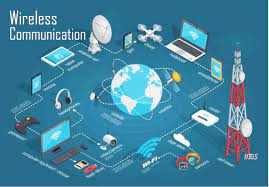Wireless communication technologies play a crucial role in enabling the Internet of Things (IoT). These technologies provide the means for devices to connect, communicate, and exchange data wirelessly. Here are some commonly used wireless communication technologies in IoT:
- Bluetooth: Bluetooth is a short-range wireless technology designed for low-power, peer-to-peer communication. It is widely used for connecting IoT devices to smartphones, wearables, and other nearby devices. Bluetooth Low Energy (BLE) is particularly suitable for IoT applications due to its low power consumption and ability to transmit small bursts of data.
- Wi-Fi (Wireless Fidelity): Wi-Fi is a widely used wireless technology that provides high-speed, local area network (LAN) communication. It offers broader coverage compared to Bluetooth and is suitable for IoT applications that require higher bandwidth, such as video streaming, smart home automation, and industrial monitoring.
- Zigbee: Zigbee is a low-power, wireless communication protocol designed for low-data-rate IoT applications. It operates on the IEEE 802.15.4 standard and provides a mesh network topology. Zigbee is commonly used in home automation, building automation, and industrial applications where low power consumption and reliable communication are essential.
- Z-Wave: Z-Wave is another low-power, wireless protocol designed for home automation and smart devices. It operates in the sub-GHz frequency range, providing reliable communication and wide coverage. Z-Wave uses a mesh network topology and is known for its interoperability among different vendors’ devices.
- LoRaWAN (Long Range Wide Area Network): LoRaWAN is a wireless communication protocol designed for long-range, low-power IoT applications. It operates in unlicensed frequency bands and enables long-range communication with low data rates. LoRaWAN is suitable for applications like smart cities, agriculture, and asset tracking, where wide-area coverage is required.
- NB-IoT (Narrowband IoT): NB-IoT is a cellular communication standard designed specifically for IoT devices. It operates in licensed cellular spectrum, offering wide-area coverage, deep building penetration, and long battery life. NB-IoT is well-suited for large-scale IoT deployments, such as smart cities, agriculture, and utilities.
- Cellular (2G, 3G, 4G, 5G): Cellular networks provide wide-area coverage and connectivity for IoT devices. They enable IoT devices to connect to the internet and cloud platforms. Cellular networks have evolved from 2G to 5G, with each generation offering improved data rates, lower latency, and better support for IoT devices. Cellular connectivity is suitable for applications that require mobility, high bandwidth, and reliable connectivity.
These are some of the wireless communication technologies commonly used in IoT applications. The choice of wireless technology depends on factors such as range requirements, power consumption, data rate, scalability, and the specific needs of the IoT application.
SHARE
